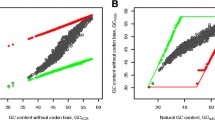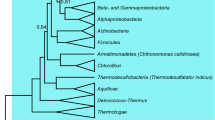Abstract
The frequencies of A, C, G, and T in mitochondrial DNA vary among species due to unequal rates of mutation between the bases. The frequencies of bases at fourfold degenerate sites respond directly to mutation pressure. At first and second positions, selection reduces the degree of frequency variation. Using a simple evolutionary model, we show that first position sites are less constrained by selection than second position sites and, therefore, that the frequencies of bases at first position are more responsive to mutation pressure than those at second position. We define a measure of distance between amino acids that is dependent on eight measured physical properties and a similarity measure that is the inverse of this distance. Columns 1, 2, 3, and 4 of the genetic code correspond to codons with U, C, A, and G in their second position, respectively. The similarity of amino acids in the four columns decreases systematically from column 1 to column 2 to column 3 to column 4. We then show that the responsiveness of first position bases to mutation pressure is dependent on the second position base and follows the same decreasing trend through the four columns. Again, this shows the correlation between physical properties and responsiveness. We determine a proximity measure for each amino acid, which is the average similarity between an amino acid and all others that are accessible via single point mutations in the mitochondrial genetic code structure. We also define a responsiveness for each amino acid, which measures how rapidly an amino acid frequency changes as a result of mutation pressure acting on the base frequencies. We show that there is a strong correlation between responsiveness and proximity, and that both these quantities are also correlated with the mutability of amino acids estimated from the mtREV substitution rate matrix. We also consider the variation of base frequencies between strands and between genes on a strand. These trends are consistent with the patterns expected from analysis of the variation among genomes.












Similar content being viewed by others
References
Adachi J, Hasegawa M (1996) Model of amino acid substitution in proteins encoded by mitochondrial DNA. J Mol Evol 42:459–468
Alff-Steinberger C. (1969) The genetic code and error transmission. Proc Natl Acad Sci USA 64:584–591
Antezana MA, Kreitman M (1999) The nonrandom location of synonymous codons suggests that reading frame-independent forces have patterned codon preferences. JMol Evol 49:36–43
Bielawski JP, Gold JR. (2002) Mutation patterns of mitochondrial H- and L-strand DNA in closely related cyprinid fishes. Genetics 161:1589–1597
Bharanidharan D, Bhargavi GR, Uthanumallian K, Gautham N (2004) Correlations between nucleotide frequencies and amino acid composition in 115 bacterial species. Biochem Biophys Res Commun 315:1097–1103
Bogenhagen DF, Clayton DA (2003) The mitochondrial DNA replication bubble has not burst. Trends Biochem Sci 28:357–360
Bowmaker M, Yang MY, Yasukawa T, Reyes A, Jacobs HT, Huberman JA, Holt IJ (2003) Mammalian mitochondrial DNA replicates bidirectionally from an initiation zone. J Biol Chem 278:50961–50969
Coghlan A, Wolfe KH (2000) Relationship of codon bias to mRNA concentration and protein length in Saccharomyces cerevisiae. Yeast 16:1131–1145
Creighton TE (1993) Proteins: Structures and molecular properties, end ed. W. H. Freeman, New York
Dayhoff MO, Schwartz RM, Orcutt BC (1978) A model of evolutionary change in proteins. In: Atlas of protein sequence and structure. National Biomedical Research Foundation, Washington, DC, Vol 5, Suppl 3, pp 345–352
Dean MD, Ballard JWO (2005) High divergence among Drosophila simulans mitochondrial haplogroups arose in the midst of long term purifying selection. Mol Phylogenet Evol 36:328–337
Duret L (2000) tRNA gene number and codon usage in the C. elegans genome are coadapted for optimal translation of highly expressed genes. Trends Genet 16:287–289
Engelman DA, Steitz TA, Goldman A (1986) Identifying nonpolar transbilayer helices in amino acid sequences of membrane proteins. Annu Rev Biophys Biophys Chem 15:321–353
Faith JJ, Pollock DD (2003) Likelihood analysis of asymmetrical mutation bias gradients in vertebrate mitochondrial genomes. Genetics 165:735–745
Foster PG, Hickey DA (1999) Compositional bias may affect both DNA-based and protein-based phylogenetic reconstructions. J Mol Evol 48:284–290
Foster PG, Jermiin LS, Hickey DA (1997) Nucleotide compositional bias affects amino acid content in proteins coded by animal mitochondria. J Mol Evol 44:282–288
Freeland SJ, Knight RD, Landweber LF, Hurst LD (2000) Early fixation of an optimal genetic code. Mol Biol Evol 17:511–518
Gibson A, Gowri-Shankar V, Higgs PG, Rattray M (2005) A comprehensive analysis of mammalian mitochondrial genome base composition and improved phylogenetic methods. Mol Biol Evol 22:251–264
Gilis D, Massar S, Cerf NJ, Rooman M (2001) Optimality of the genetic code with respect to protein stability and amino acid frequencies. Genome Biol 2(11):research00491
Goldman N, Yang Z. (1994) A codon-based model of nucleotide substitution for protein coding DNA sequences. Mol Biol Evol 11:725–736
Grantham R (1974) Amino acid difference formula to help explain protein evolution. Science 185:862–864
Haig D, Hurst LD (1991) A quantitative measure of error minimization in the genetic code. J Mol Evol 33:412–417
Halpern AL, Bruno WJ (1998) Evolutionary distances for protein-coding sequences: modeling site-specific residue frequencies. Mol Biol Evol 15:910–917
Hasegawa M, Kishino H, Yano TA (1985) Dating of the human-ape splitting by a molecular clock of mitochondrial DNA. J Mol Evol 22:160–174
Hasegawa M, Cao Y, Yang Z (1998) Preponderence of slightly deleterious polymorphism in mitochondrial DNA: nonsynonymous/synonymous rate ratio is much higher within species than between species. Mol Biol Evol 15:1499–1505
Higgs PG, Attwood TK (2005) Bioinformatics and molecular evolution. Blackwell, Malden, MA
Jameson D, Gibson AP, Hudelot C, Higgs PG (2003) OGRe: a relational database for comparative analysis of mitochondrial genomes. Nucleic Acids Res 31:202–206 (latest version available at http://ogre.mcmaster.ca)
Jones DT, Taylor WR, Thornton JM (1992) The rapid generation of mutation data matrices from protein sequences. CABIOS 8:275–282
Kanaya S, Yamada Y, Kudo Y, Ikemura T (1999) Studies of codon usage and tRNA genes of 18 unicellular organisms and quantification of Bacillus subtilis tRNAs. Gene 238:143–155
Kimura M (1983) The neutral theory of molecular evolution. Cambridge University Press, Cambridge
Knight RD, Freeland SJ, Landweber LF (2001a) A simple model based on mutation and selection explains trends in codon and amino acid usage and GC composition within and across genomes. Genome Biol 2(4):research00101
Knight RD, Landweber LF, Yarus M (2001b) How mitochondria redefine the code. J Mol Evol 53:299–313
Krishnan NM, Seligmann H, Raina SZ, Pollock DD. (2004) Detecting gradients of asymmetry in site-specific substitutions in mitochondrial genomes. DNA Cell Biol 23:707–714
Kyte J, Doolittle RF (1982) A simple method for displaying the hydropathic character of a protein. J Mol Biol 157:105–132
Lobry JR (1997) Influence of genomic G+C content on average amino acid composition of proteins from 59 bacterial species. Gene 205:309–316
McLean MJ, Wolfe KH, Devine KM (1998) Base composition skews, replication orientation and gene orientation in 12 prokaryote genomes. J Mol Evol 47:691–696
Miller S, Janin J, Lesk AM, Chothia C (1987) Interior and surface of monomeric proteins. J Mol Biol 196:641–657
Muto A, Osawa S (1987) The guanine and cytosine content of genomic DNA and bacterial evolution. Proc Natl Acad Sci USA 84:166–169
Raina SZ, Faith JJ, Dusotell TR, Seligmann H, Stewart CB, Pollock DD. (2005) Evolution of base-substitution gradients in primate mitochondrial genomes. Genome Res 15:665–673
Reyes A, Gissi C, Pesole G, Saccone C (1998) Asymmetrical directional mutation pressure in the mitochondrial genome of mammals. Mol Biol Evol 15:957–966
Rose GD, Geselowitz AR, Lesser GJ, Lee RH, Zehfus MH (1985) Hydrophobicity of amino acid residues in globular proteins. Science 228:834–838
Schmitz J, Ohme M, Zischler H (2002) The complete mitochondrial sequence of Tarsius bancanus: evidence for an extensive nucleotide compositional plasticity of primate mitochondrial DNA. Mol Biol Evol 19:544–553
Sengupta S, Higgs PG (2005) A unified model of codon reassignment in alternative genetic codes. Genetics 170:831–840
Singer GAC, Hickey DA (2000) Nucleotide bias causes a genome wide bias in the amino acid composition of proteins. Mol Biol Evol 17:1581–1588
Sueoka N (1988) Directional mutation pressure and neutral molecular evolution. Proc Natl Acad Sci USA 85:2653–2657
Sueoka N (1995) Intra-strand parity rules of DNA base composition and usage biases of synonymous codons. J Mol Evol 40:318–325
Sueoka N (1999) Two aspects of DNA base composition:G+C content and translation-coupled deviation from intra-strand rule of A = T and G = C. J Mol Evol 49:49–62
Tanaka M, Ozawa T (1994) Strand asymmetry in human mitochondrial DNA mutations. Genomics 22:327–335
Woese CR (1965) On the evolution of the genetic code. Proc Natl Acad Sci USA 54:1546–1552
Woese CR, Dugre DH, Saxinger WC, Dugre SA (1966). The molecular basis for the genetic code. Proc Natl Acad Sci USA 55:966–974
Zimmerman JM, Eliezer N, Simha R (1968) The characterization of amino acids sequences in proteins by statistical methods. J Theor Biol 21:170–201
Acknowledgments
This work was supported by the Natural Sciences and Engineering Research Council of Canada and by Canada Research Chairs.
Author information
Authors and Affiliations
Corresponding author
Additional information
[Reviewing Editor: Dr. David Pollock]
Rights and permissions
About this article
Cite this article
Urbina, D., Tang, B. & Higgs, P.G. The Response of Amino Acid Frequencies to Directional Mutation Pressure in Mitochondrial Genome Sequences Is Related to the Physical Properties of the Amino Acids and to the Structure of the Genetic Code. J Mol Evol 62, 340–361 (2006). https://doi.org/10.1007/s00239-005-0051-1
Received:
Accepted:
Published:
Issue Date:
DOI: https://doi.org/10.1007/s00239-005-0051-1




